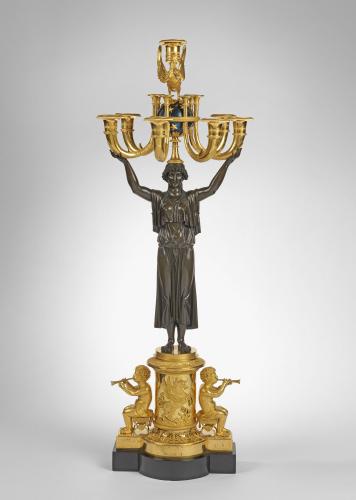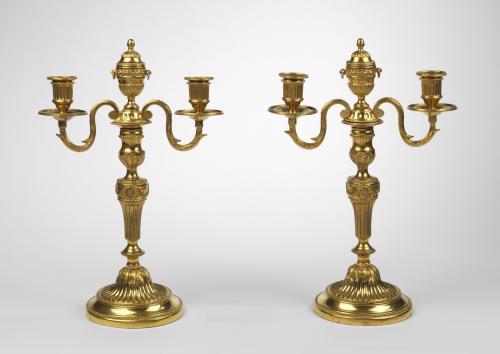

Price on application
This object is eligible for a Certificate of BADA Provenance
The BADA Standard
- Since 1918, BADA has been the leading association for the antiques and fine art trade
- Members are elected for their knowledge, integrity and quality of stock
- Our clients are protected by BADA’s code of conduct
- Our dealers’ membership is reviewed and renewed annually
- Bada.org is a non-profit site: clients deal directly with members and they pay no hidden fees
Each with a pair of classical female figures holding aloft a tapered urn, issuing a central tapering column on a cylindrical part-fluted white marble socle mounted with a band of foliate scrolls issuing anthemions above a beaded and stiff leaf collar, on square marble base.
Provenance:
The Earls of Harewood, Harewood House, Yorkshire.
Probably acquired by Edward Lascelles, 1st Earl of Harewood (1740–1820) or his son Edward ‘Beau’ Lascelles, Viscount Lascelles (1764-1814) or inherited in 1916 as part of the Clanricarde bequest or later purchased by Henry Lascelles, 6th Earl of Harewood (1882- 1947), and by descent at Harewood House, Yorkshire.
Literature:
These superb candelabra were probably executed by the celebrated bronzier François Rémond (c. 1747-1812), on behalf of a marchand-mercier such as Dominique Daguerre (d.1796), based on a number of stylistic attributes. The distinctive eagle with outspread wings is seen on a clock by Rémond for which a design exists (H. Ottomeyer, P. Pröschel et al., Vergoldete Bronzen, Munich, 1986, p. 295, figs. 4.17.5-6), and also on pairs of wall-lights, attributed to Remond, who worked extensively for Daguerre. On 17 December 1786, Daguerre delivered two pairs of this model to the French crown; they now adorn the salon des jeux du Roi at the château de Versailles (D. Meyer, Versailles, Furniture of the Royal Palace 17th and 18th Centuries, vol. I, Dijon, 2002, p.154; P. Lemoine, The Palace of Versailles, Paris, 1987, p. 86). Daguerre supplied a further three pairs of the same model - fitted like the Versailles example with three branches - for the salon d'audience du Garde des Sceaux in the hôtel de la Chancellerie at Versailles. Furthermore, the spiral-gadrooned candle-branches of the present candelabras are also found as a central candle-branch on a girandole by Rémond (Ottomeyer, Pröschl, op. cit., p. 266, fig. 4.9.5).
At least eight pairs of candelabra of this model in addition to this pair, but with variations to the candle-branches and bases, are recorded: a four-light pair, surmounted, as in this example, with an eagle with outspread wings, at Pavlovsk, near St. Petersburg (E. Ducamp, Pavlousk Les Collections, Paris, 1993, p. 189, no. 30); a four-light pair in the musée
Nissim de Camondo, Paris (the latter acquired from Seligmann in 1925. N. Gasc, The Nissim de Camondo Museum, Paris, 1991, p. 61, inv. 86); a four-light pair, again with eagle, illustrated in Ottomeyer, Pröschl, op. cit., p. 284, fig. 4.14.10; a four-light pair with Etienne Ader, Paris, 24 March 1955, lot 62; a six-light pair, ‘The Gutzwiller Collection’, Sotheby’s Monaco 1 July 1995, lot 100; a four-light pair, ‘The Wildenstein Collection’, Christie’s London, 14-15 December 2005, lot 19, an eight-light pair, Sotheby’s London 10 July 2013, lot 150 and a pair of single lamps, Christie’s, New York, 20 May 2014, lot 213.
This model possibly derives from a design by Falconet described in the salon of 1761 as: ‘119. Deux Grouppes de femmes en plâtre. Ce sont des Chandeliers pour être exécutés en argent. Ils ont deux pieds six pouces de haut chacun’ (Sculptures et gravures de Messieurs de l’Académie royale…dans le grand Salon du Louvre pour l’année 1761). However, the model is closer still to a later drawing by Gabriel Saint-Aubin, illustrated Ottomeyer, Pröschel, op. cit., p. 284, fig. 4.14.11.
An alternative source of inspiration for the figurative groups may have been François-Joseph Duret (1729-1816), who supplied related figures for the organ at Saint-Sulpice, made between 1778-1782, although the actual design may lie with the architect Jean-François Chalgrin (1739-1811) (Bruno Pons, 'Un Collaborateur de Chalgrin; François-Joseph Duret', Bulletin de la Société de l'Histoire de l'Art Français, Paris, 1985, p.160, fig.160).
THE HAREWOOD PROVENANCE
A pair of seven-light candelabras of a related but later model, 1800-13, is in the Royal Collection; these were acquired by George, Prince of Wales (later George IV) for Carlton House, London (RCIN 2716). Their presence in the Prince of Wales’ collection suggests a possible provenance for the Harewood candelabras. Edward, Viscount Lascelles (c. 1767-1814) was known to emulate the Prince’s collecting practices, as were all in the latter’s set; ‘Beau’ Lascelles, and his father, Edward, 1st Earl of Harewood (1740-1820), frequented many of the same dealers and craftsmen used by the Prince – Robert Fogg, Dominique Daguerre, Alexis Decaix, to name a few. Lascelles was often mistaken for the Prince of Wales, due to a marked physical resemblance, which earned him the sobriquet ‘Beau’, and for his penchant for dressing in the most fashionable style. Joseph Farrington, art connoisseur and diarist, noted: ‘Young Mr. Lascelles is reckoned very like the Prince of Wales. The Prince is not pleased at it. He calls Lascelles the Pretender’ (C. Kennedy, Harewood, The Life and Times of an English Country House, London, 1982, p. 61).
Interestingly, a striated white marble base is frequently found on clock bases by the Royal clockmakers and bronziers Vulliamy, and it is possible that the Vulliamy firm had seen the present candelabras in situ and copied the motif (see R. Smith, ‘Vulliamy’s Sculptural Clocks’, British Ceramic Design 1600-2002, London, 2003, p. 131, fig. 14 and p. 133, fig. 16 - sold Christie’s, New York, 19 January 1996, lot 510). The Vulliamys reproduced French designs and works of art, or parts of the latter; the firm’s records for ‘Beau’ Lascelles and Lord Harewood show that they were adding stands to porcelain, and supplying French candelabra,
which they re-gilded prior to delivery to their Harewood patrons (G. de Bellaigue, ‘The Vulliamys and France’, Furniture History Society, vol. 3, 1967, p. 46).
Dimensions
32.5 x 27.5 x 105cm HighThe BADA Standard
- Since 1918, BADA has been the leading association for the antiques and fine art trade
- Members are elected for their knowledge, integrity and quality of stock
- Our clients are protected by BADA’s code of conduct
- Our dealers’ membership is reviewed and renewed annually
- Bada.org is a non-profit site: clients deal directly with members and they pay no hidden fees




